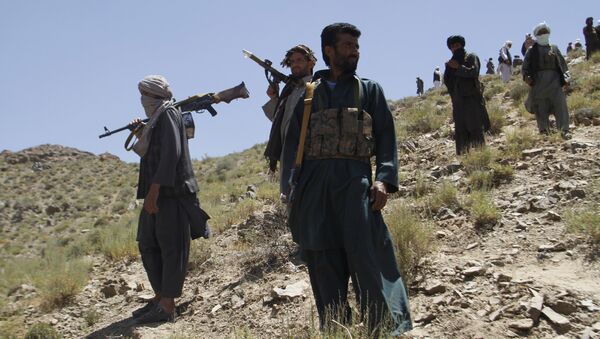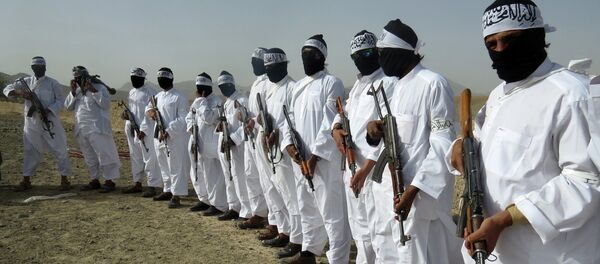US strategic bombers B-52 Sratofortress conducted attacks on Taliban bases in Afghanistan on the border with Tajikistan and China, NATO Air Force commander in Afghanistan James Hecker told reporters.
According to Hecker, the aerial operations against the training bases of the Taliban and East Turkistan Islamic Movement (ETIM) in the Badakhshan province in Afghanistan, which were carried out by the US forces over the past week, prevented terrorists from planning their actions near the border with China and Tajikistan.
READ MORE: Pentagon to Shift Troops to Afghanistan From Iraq
The ETIM is a terrorist organization that operates in China and the border regions of Afghanistan, Hecker said. The terrorist group receives support from the Taliban in the mountains of Badakhshan, he added.
The NATO Air Force commander said that the strikes destroyed cars which were stolen from the Afghan military and converted into "moving bombs" for carrying out terrorist acts.
With the latest airstrikes Washington seems to have started a new wave of the air war in Afghanistan, as the attacked Badakhshan province in the Hindu Kush and Pamir mountain ranges was previously rarely targeted by the US-led military coalition in Afghanistan.
New US Strategy in Afghanistan
On the heels of Trump's calls to increase the number of US troops in Afghanistan, US Central Command (CENTCOM) head Gen. Joseph Votel announced that more US soldiers would begin to arrive in Afghanistan soon. The US move was widely criticized by Afghanistan's former president Hamid Karzai, who noted that the Trump's decision might lead to more bloodshed.
According to the US Air Forces Central Command's report, September of 2017 saw a 50-percent increase in the number of bombs dropped by the United States military on Afghanistan in comparison to August, with 751 bombs released by Washington becoming the highest monthly total in the past seven years.
READ MORE: Terrorist Attack on Russian Embassy in Afghanistan Foiled — Source
The US August's strategy was believed to force Taliban to the negotiating table and result in the end of the US longest foreign war. However, on January 29, Trump rejected the idea of talks with the Taliban in the wake of deadly terrorist attacks in Kabul, which claimed lives of hundreds of people.
In January, US media reported that within the framework of the new US strategy in Afghanistan, Washington would send additional unmanned aerial vehicles (UAVs) and about 1,000 new combat advisers to the war-ravaged state in order to prepare for the expected escalation in spring.
Taliban Movement and US War in Afghanistan
The new US startegy in Afghanistan was aimed at ending the longest foreign war which Washington has been waging in the country since 2001.
The anti-terrorist military operation of the US-led coalition in Afghanistan started as a response to the September 11 attacks, as the Taliban group operating in Afghanistan was accused by the US of providing a sanctuary to al-Qaeda and its leader Osama Bin Laden, who were blamed for the terrorist acts.
READ MORE: Iranian General Staff Accuses US of Transferring Daesh Terrorists to Afghanistan
As a result of the operation by December 2001 the Taliban was driven from power in Afghanistan and NATO-led International Security Assistance Force (ISAF) contingent later deployed in the country after the UN Security Council authorized the move. In 2003, the Taliban managed to reorganize and launched an insurgency against the Afghan government and ISAF units.
The militants of the Taliban radical movement are active on 70 percent of the Afghan territory, fully controlling 4 percent of the nation and demonstrating presence in another 66 percent, a BBC study conducted on August — November 2017 found. In addition, the research reveals that that the number of districts with Taliban's presence has increased since the mission carried out by the United States and its allies in Afghanistan ended in 2014 and the foreign troops were formally withdrawn from the country.
According to @BBC's latest report #Taliban have their strong presence in 70% of #Afghanistan. pic.twitter.com/qGy9fOQNqV
— umair aziz (@iumairaziz) January 31, 2018
The Taliban is a fundamentalist movement which seeks to enforce the rule of Islamic law in Afghanistan. The group emerged in 1994 during the civil war in the country and held power on the most part of the Afghan territory in the period from 1996 to 2001. The Taliban is listed as a terrorist organization by the UN Secvurity Council, Russia and the US.




